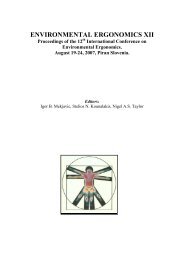Development of self-compacting concrete
Development of self-compacting concrete
Development of self-compacting concrete
Create successful ePaper yourself
Turn your PDF publications into a flip-book with our unique Google optimized e-Paper software.
Design criteria Detailing criteria Blocking criteria Void content<br />
Air<br />
content<br />
w/c ratio<br />
Cement type<br />
Strength<br />
development<br />
Slump loss<br />
Contractor<br />
requirements<br />
Gap<br />
International RILEM Symposium on SCC in Stockholm in<br />
1999. 15 The papers included 23 from Asia, 38 from Europe,<br />
five from North America and one from Australia. The<br />
symposium attracted 340 participants from 35 countries, which<br />
is a ratio <strong>of</strong> 5 to 1 <strong>of</strong> participants to papers, indicating the<br />
increasing interest in the material in Europe.<br />
4. EUROPEAN DEVELOPMENT<br />
<strong>Development</strong> and use <strong>of</strong> SCC began to quickly spread from<br />
Sweden to other Scandinavian countries at the end <strong>of</strong> the<br />
1990s. The <strong>concrete</strong> industry in countries such as France and<br />
the Netherlands have also recently been developing and using<br />
the material, with countries such as Germany and the UK<br />
progressing closely behind. All <strong>of</strong> these countries have now<br />
Minimum paste volume<br />
Fine mortar rheology<br />
Optimal combination <strong>of</strong> fine<br />
mortar constituent materials<br />
Verification <strong>of</strong> <strong>concrete</strong><br />
properties<br />
Fig. 3. A mix design model for SCC developed by the CBI <strong>of</strong> Sweden 16<br />
Fig. 4. A Swedish road bridge cast in SCC 16<br />
Aggregate<br />
PSD/shape<br />
Blocking?<br />
Segregation?<br />
used SCC in both in situ and precast applications. Countries<br />
such as Greece and the Eastern European countries are still<br />
mainly conducting research and development or are at the<br />
initial site trial stage.<br />
Two European-wide research projects are currently under way<br />
in the field <strong>of</strong> SCC.<br />
(a) Following the completion <strong>of</strong> the European-wide SCC Brite-<br />
EuRam project in 2000, it was clear that the remaining<br />
fundamental obstacle to the material’s wider use in Europe<br />
was the absence <strong>of</strong> suitable test methods to identify its<br />
three key properties (i.e. passing ability, filling ability and<br />
resistance to segregation). The EU therefore agreed to<br />
support an additional three-year project from 2001 to 2004<br />
through its Growth programme (Growth Project GRD2-<br />
2000-30024) to develop test methods for SCC and to<br />
prepare the way for European standardisation. The project<br />
involves twelve European partners and is led by the<br />
University <strong>of</strong> Paisley, Scotland. For additional details see<br />
Reference 19.<br />
(b) A RILEM committee was also formed in September 2000 to<br />
focus on assembling relevant existing knowledge on<br />
various aspects on the casting <strong>of</strong> SCC. 20 The committee<br />
aims to build further on the work <strong>of</strong> RILEM TC 174-SCC<br />
mentioned in the previous section and the objective is to<br />
find links between the fundamental basic mechanisms <strong>of</strong><br />
SCC and the current practical experience regarding SCC. 21<br />
The knowledge will be further developed through technical<br />
discussions and a workshop and will result in a report on<br />
the existing available knowledge on the casting <strong>of</strong> SCC.<br />
408 Structures & Buildings 156 Issue SB4 Self-<strong>compacting</strong> <strong>concrete</strong> development<br />
Goodier
















